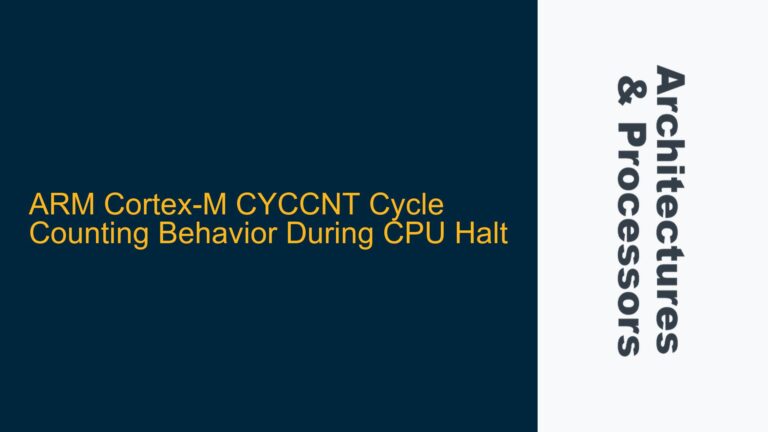Flash Memory CRC Check Mechanism and Its Disabling in ARM Cortex-M3
The ARM Cortex-M3 microcontroller architecture incorporates a Flash Memory Cyclic Redundancy Check (CRC) mechanism to ensure data integrity during runtime. This mechanism is designed to verify the integrity of the Flash memory contents by computing a CRC value and comparing it against a precomputed reference value. However, certain use cases, such as firmware updates or debugging, may require disabling this CRC check to avoid unnecessary overhead or to bypass potential errors during development.
The specific code snippet const unsigned int iPage0CS[2] __at(0x07F8) = {0xFFFFFFFF, 0x16400000}; is a programming construct used to disable the CRC check by writing specific values to a predefined memory address. This technique is often employed in embedded systems to manipulate hardware behavior at a low level. The address 0x07F8 is a special memory-mapped register location in the Cortex-M3 architecture, and the values 0xFFFFFFFF and 0x16400000 are magic numbers that signal the hardware to disable the CRC check.
The Flash memory CRC check is typically implemented in the microcontroller’s bootloader or runtime library. When enabled, the CRC check ensures that the Flash memory contents have not been corrupted, which is critical for mission-critical applications. However, during development or firmware updates, the CRC check can become a hindrance, as it may flag legitimate changes to the Flash memory as errors. Disabling the CRC check allows developers to bypass this verification step, enabling faster iteration and debugging.
The use of the __at keyword in the code snippet is significant. This keyword is a compiler-specific extension that allows developers to place variables at specific memory addresses. In this case, the array iPage0CS is placed at address 0x07F8, which corresponds to the memory-mapped register responsible for controlling the CRC check mechanism. The values 0xFFFFFFFF and 0x16400000 are written to this address to disable the CRC check.
Memory-Mapped Register Configuration and Magic Number Usage
The memory-mapped register at address 0x07F8 is a hardware-specific configuration register that controls various aspects of the Flash memory subsystem, including the CRC check mechanism. Writing specific values to this register can alter the behavior of the Flash memory controller, enabling or disabling features such as the CRC check.
The values 0xFFFFFFFF and 0x16400000 are magic numbers that are recognized by the hardware as commands to disable the CRC check. These values are not arbitrary; they are defined in the microcontroller’s reference manual and are specific to the Cortex-M3 architecture. The first value, 0xFFFFFFFF, is often used as a placeholder or default value in embedded systems, while the second value, 0x16400000, is a specific command that instructs the Flash memory controller to disable the CRC check.
The use of magic numbers in embedded systems is a common practice for configuring hardware registers. These numbers are typically defined in the microcontroller’s reference manual and are used to set specific bits in the register to achieve the desired behavior. In this case, the combination of 0xFFFFFFFF and 0x16400000 sets the appropriate bits in the register at address 0x07F8 to disable the CRC check.
The placement of the array iPage0CS at address 0x07F8 is critical. If the array is not placed at the correct address, the values 0xFFFFFFFF and 0x16400000 will not be written to the correct register, and the CRC check will not be disabled. The __at keyword ensures that the array is placed at the correct address, allowing the values to be written to the appropriate register.
Implementing CRC Check Disabling in Firmware Development
To implement the disabling of the Flash memory CRC check in firmware development, developers must follow a series of steps to ensure that the CRC check is properly disabled and that the system continues to operate as expected. The first step is to identify the memory-mapped register responsible for controlling the CRC check mechanism. This information is typically found in the microcontroller’s reference manual.
Once the correct register has been identified, the next step is to determine the magic numbers required to disable the CRC check. These values are also found in the reference manual and are specific to the microcontroller’s architecture. In the case of the Cortex-M3, the values 0xFFFFFFFF and 0x16400000 are used to disable the CRC check.
The next step is to write the magic numbers to the correct memory address using the __at keyword. This ensures that the values are written to the correct register, allowing the CRC check to be disabled. The following code snippet demonstrates how to do this:
const unsigned int iPage0CS[2] __at(0x07F8) = {0xFFFFFFFF, 0x16400000};
This code places the array iPage0CS at address 0x07F8 and initializes it with the values 0xFFFFFFFF and 0x16400000. When the firmware is executed, these values are written to the memory-mapped register, disabling the CRC check.
It is important to note that disabling the CRC check can have implications for the system’s reliability. Without the CRC check, the system will not be able to detect corruption in the Flash memory, which could lead to unexpected behavior or system failures. Therefore, it is recommended to only disable the CRC check during development or firmware updates and to re-enable it once the updates are complete.
To re-enable the CRC check, developers must write the appropriate values to the memory-mapped register. The values required to re-enable the CRC check are also found in the microcontroller’s reference manual. The following code snippet demonstrates how to re-enable the CRC check:
const unsigned int iPage0CS[2] __at(0x07F8) = {0x00000000, 0x00000000};
This code places the array iPage0CS at address 0x07F8 and initializes it with the values 0x00000000 and 0x00000000. When the firmware is executed, these values are written to the memory-mapped register, re-enabling the CRC check.
In conclusion, the disabling of the Flash memory CRC check in the ARM Cortex-M3 architecture is a powerful technique that can be used to streamline firmware development and updates. By understanding the memory-mapped register configuration and the use of magic numbers, developers can effectively disable and re-enable the CRC check as needed. However, it is important to use this technique judiciously, as disabling the CRC check can have implications for the system’s reliability.






